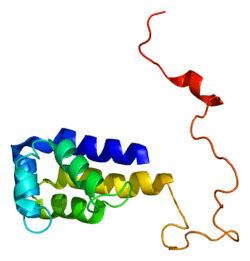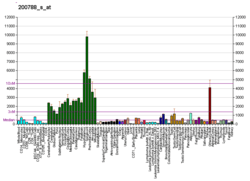PEA15
Astrocytic phosphoprotein PEA-15 is a protein that in humans is encoded by the PEA15 gene.[5][6]
PEA15 is a death effector domain (DED)-containing protein predominantly expressed in the central nervous system, particularly in astrocytes.[6]
PEA-15 promotes autophagy in glioma cells in a JNK-dependent manner.[7]
Interactions
PEA15 has been shown to interact with:
gollark: ++remind 19h shift tabs
gollark: https://bldgblog.com/tag/zachary-mason/
gollark: https://bldgblog.com/tag/zachary-mason/
gollark: ++remind "monday 16th may 12:00" investigate student finance website
gollark: ++remind "monday 16 12:00" investigate student finance website
References
- GRCh38: Ensembl release 89: ENSG00000162734 - Ensembl, May 2017
- GRCm38: Ensembl release 89: ENSMUSG00000013698 - Ensembl, May 2017
- "Human PubMed Reference:". National Center for Biotechnology Information, U.S. National Library of Medicine.
- "Mouse PubMed Reference:". National Center for Biotechnology Information, U.S. National Library of Medicine.
- Hwang S, Kuo WL, Cochran JF, Guzman RC, Tsukamoto T, Bandyopadhyay G, Myambo K, Collins CC (September 1997). "Assignment of HMAT1, the human homolog of the murine mammary transforming gene (MAT1) associated with tumorigenesis, to 1q21.1, a region frequently gained in human breast cancers". Genomics. 42 (3): 540–2. doi:10.1006/geno.1997.4768. PMID 9205133.
- "Entrez Gene: PEA15 phosphoprotein enriched in astrocytes 15".
- Böck BC, Tagscherer KE, Fassl A, Krämer A, Oehme I, Zentgraf HW, Keith M, Roth W (July 2010). "The PEA-15 protein regulates autophagy via activation of JNK". J. Biol. Chem. 285 (28): 21644–54. doi:10.1074/jbc.M109.096628. PMC 2898427. PMID 20452983.
- Kitsberg D, Formstecher E, Fauquet M, Kubes M, Cordier J, Canton B, Pan G, Rolli M, Glowinski J, Chneiweiss H (October 1999). "Knock-out of the neural death effector domain protein PEA-15 demonstrates that its expression protects astrocytes from TNFalpha-induced apoptosis". J. Neurosci. 19 (19): 8244–51. doi:10.1523/JNEUROSCI.19-19-08244.1999. PMC 6783010. PMID 10493725.
- Condorelli G, Vigliotta G, Cafieri A, Trencia A, Andalò P, Oriente F, Miele C, Caruso M, Formisano P, Beguinot F (August 1999). "PED/PEA-15: an anti-apoptotic molecule that regulates FAS/TNFR1-induced apoptosis". Oncogene. 18 (31): 4409–15. doi:10.1038/sj.onc.1202831. PMID 10442631.
- Formstecher E, Ramos JW, Fauquet M, Calderwood DA, Hsieh JC, Canton B, Nguyen XT, Barnier JV, Camonis J, Ginsberg MH, Chneiweiss H (August 2001). "PEA-15 mediates cytoplasmic sequestration of ERK MAP kinase". Dev. Cell. 1 (2): 239–50. doi:10.1016/s1534-5807(01)00035-1. PMID 11702783.
- Zhang Y, Redina O, Altshuller YM, Yamazaki M, Ramos J, Chneiweiss H, Kanaho Y, Frohman MA (November 2000). "Regulation of expression of phospholipase D1 and D2 by PEA-15, a novel protein that interacts with them". J. Biol. Chem. 275 (45): 35224–32. doi:10.1074/jbc.M003329200. PMID 10926929.
- Vaidyanathan H, Ramos JW (August 2003). "RSK2 activity is regulated by its interaction with PEA-15". J. Biol. Chem. 278 (34): 32367–72. doi:10.1074/jbc.M303988200. PMID 12796492.
Further reading
- Araujo H, Danziger N, Cordier J, Glowinski J, Chneiweiss H (1993). "Characterization of PEA-15, a major substrate for protein kinase C in astrocytes". J. Biol. Chem. 268 (8): 5911–20. PMID 8449955.
- Estellés A, Yokoyama M, Nothias F, Vincent JD, Glowinski J, Vernier P, Chneiweiss H (1996). "The major astrocytic phosphoprotein PEA-15 is encoded by two mRNAs conserved on their full length in mouse and human". J. Biol. Chem. 271 (25): 14800–6. doi:10.1074/jbc.271.25.14800. PMID 8662970.
- Condorelli G, Vigliotta G, Iavarone C, Caruso M, Tocchetti CG, Andreozzi F, Cafieri A, Tecce MF, Formisano P, Beguinot L, Beguinot F (1998). "PED/PEA-15 gene controls glucose transport and is overexpressed in type 2 diabetes mellitus". EMBO J. 17 (14): 3858–66. doi:10.1093/emboj/17.14.3858. PMC 1170721. PMID 9670003.
- Kubes M, Cordier J, Glowinski J, Girault JA, Chneiweiss H (1998). "Endothelin induces a calcium-dependent phosphorylation of PEA-15 in intact astrocytes: identification of Ser104 and Ser116 phosphorylated, respectively, by protein kinase C and calcium/calmodulin kinase II in vitro". J. Neurochem. 71 (3): 1307–14. doi:10.1046/j.1471-4159.1998.71031307.x. PMID 9721757.
- Condorelli G, Vigliotta G, Cafieri A, Trencia A, Andalò P, Oriente F, Miele C, Caruso M, Formisano P, Beguinot F (1999). "PED/PEA-15: an anti-apoptotic molecule that regulates FAS/TNFR1-induced apoptosis". Oncogene. 18 (31): 4409–15. doi:10.1038/sj.onc.1202831. PMID 10442631.
- Kitsberg D, Formstecher E, Fauquet M, Kubes M, Cordier J, Canton B, Pan G, Rolli M, Glowinski J, Chneiweiss H (1999). "Knock-out of the neural death effector domain protein PEA-15 demonstrates that its expression protects astrocytes from TNFalpha-induced apoptosis". J. Neurosci. 19 (19): 8244–51. doi:10.1523/JNEUROSCI.19-19-08244.1999. PMC 6783010. PMID 10493725.
- Wolford JK, Bogardus C, Ossowski V, Prochazka M (2000). "Molecular characterization of the human PEA15 gene on 1q21-q22 and association with type 2 diabetes mellitus in Pima Indians" (PDF). Gene. 241 (1): 143–8. doi:10.1016/S0378-1119(99)00455-2. PMID 10607908.
- Zhang Y, Redina O, Altshuller YM, Yamazaki M, Ramos J, Chneiweiss H, Kanaho Y, Frohman MA (2001). "Regulation of expression of phospholipase D1 and D2 by PEA-15, a novel protein that interacts with them". J. Biol. Chem. 275 (45): 35224–32. doi:10.1074/jbc.M003329200. PMID 10926929.
- Formstecher E, Ramos JW, Fauquet M, Calderwood DA, Hsieh JC, Canton B, Nguyen XT, Barnier JV, Camonis J, Ginsberg MH, Chneiweiss H (2001). "PEA-15 mediates cytoplasmic sequestration of ERK MAP kinase". Dev. Cell. 1 (2): 239–50. doi:10.1016/S1534-5807(01)00035-1. PMID 11702783.
- Condorelli G, Trencia A, Vigliotta G, Perfetti A, Goglia U, Cassese A, Musti AM, Miele C, Santopietro S, Formisano P, Beguinot F (2002). "Multiple members of the mitogen-activated protein kinase family are necessary for PED/PEA-15 anti-apoptotic function". J. Biol. Chem. 277 (13): 11013–8. doi:10.1074/jbc.M110934200. PMID 11790785.
- Xiao C, Yang BF, Asadi N, Beguinot F, Hao C (2002). "Tumor necrosis factor-related apoptosis-inducing ligand-induced death-inducing signaling complex and its modulation by c-FLIP and PED/PEA-15 in glioma cells". J. Biol. Chem. 277 (28): 25020–5. doi:10.1074/jbc.M202946200. PMID 11976344.
- Vaidyanathan H, Ramos JW (2003). "RSK2 activity is regulated by its interaction with PEA-15". J. Biol. Chem. 278 (34): 32367–72. doi:10.1074/jbc.M303988200. PMID 12796492.
- Trencia A, Perfetti A, Cassese A, Vigliotta G, Miele C, Oriente F, Santopietro S, Giacco F, Condorelli G, Formisano P, Beguinot F (2003). "Protein kinase B/Akt binds and phosphorylates PED/PEA-15, stabilizing its antiapoptotic action". Mol. Cell. Biol. 23 (13): 4511–21. doi:10.1128/MCB.23.13.4511-4521.2003. PMC 164852. PMID 12808093.
- Trencia A, Fiory F, Maitan MA, Vito P, Barbagallo AP, Perfetti A, Miele C, Ungaro P, Oriente F, Cilenti L, Zervos AS, Formisano P, Beguinot F (2004). "Omi/HtrA2 promotes cell death by binding and degrading the anti-apoptotic protein ped/pea-15". J. Biol. Chem. 279 (45): 46566–72. doi:10.1074/jbc.M406317200. PMID 15328349.
- Gaumont-Leclerc MF, Mukhopadhyay UK, Goumard S, Ferbeyre G (2004). "PEA-15 is inhibited by adenovirus E1A and plays a role in ERK nuclear export and Ras-induced senescence". J. Biol. Chem. 279 (45): 46802–9. doi:10.1074/jbc.M403893200. PMID 15331596.
- Renganathan H, Vaidyanathan H, Knapinska A, Ramos JW (2006). "Phosphorylation of PEA-15 switches its binding specificity from ERK/MAPK to FADD". Biochem. J. 390 (Pt 3): 729–35. doi:10.1042/BJ20050378. PMC 1199667. PMID 15916534.
This article is issued from Wikipedia. The text is licensed under Creative Commons - Attribution - Sharealike. Additional terms may apply for the media files.







